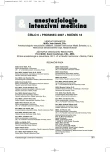Emergency Preservation and Resuscitation – nová šance pro oběti traumatické srdeční zástavy
Emergency Preservation and Resuscitation: A new chance for traumatic cardiac arrest victims
The outcomes from resuscitation of cardiac arrest victims remain suboptimal. Conventional resuscitation approach to trauma-related exsanguination cardiac arrest carries especially dismal prognosis. A majority of the patients die at the scene. However, some of the injuries could be surgically repairable. Emergency Preservation and Resuscitation (EPR) is a novel resuscitation method using large-volume ice-cold aortic flush to induce hypothermia, a key mechanism decreasing metabolic demands.This buys time for the transport, damage-control surgery and delayed resuscitation using cardiopulmonary bypass.
The depth of hypothermia correlates well with the duration of the arrest that still allows favourable neurologic outcome. In a large animal model we were able to achieve good outcome after 120 min of total cardiac arrest at 10 °C. This period provides an ample time to transport the victim from even the most remote areas to the operating theatre. Rapid onset and deeper levels of hypothermia are associated with better outcomes. The role of pharmacological adjuncts to hypothermia seems to be limited. Blood components, haemoglobin and energetic substrates may be beneficial during the induction of hypothermia. Oxygen radical scavengers can ameliorate secondary ischaemia-reperfusion injury. The potential role of EPR in normovolaemic cardiac arrest remains to be elucidated. Over the last 20 years since the original concept was formulated, EPR has progressed from experimental studies to a multicentric clinical trial, showing EPR as one of the few promising strategies for traumatic cardiac arrest victims.
Keywords:
hypothermia – cardiac arrest – suspended animation – cerebral ischaemia – resuscitation – extracorporeal circulation
Autoři:
T. Drábek
Působiště autorů:
Pennsylvania, USA
; Department of Anesthesiology, Safar Center for Resuscitation Research, University of Pittsburgh, Pittsburgh
Vyšlo v časopise:
Anest. intenziv. Med., 18, 2007, č. 6, s. 351-356
Kategorie:
Intenzivní medicína
Souhrn
Úspěšnost resuscitace obětí srdeční zástavy je stále neuspokojivá. Srdeční zástava způsobená traumatem a následným vykrvácením má za použití konvenčních technik resuscitace velmi špatnou prognózu. Většina těchto pacientů umírá přímo na místě, přestože poranění by byla chirurgicky ošetřitelná. Emergency Preservation and Resuscitation (EPR) je nová resuscitační metoda, která využívá masivní infuze ledové tekutiny do tepenného řečiště k navození hypotermie jako hlavního mechanismu snížení metabolických nároků organismu po srdeční zástavě (emergency preservation). Hypotermie během oběhové zástavy umožňuje získat čas pro převoz zraněného do nemocničního zařízení. Po chirurgické kontrole krvácení je odložená resuscitace následně zahájena s využitím mimotělního oběhu (resuscitation).
Hloubka hypotermie koreluje s dobou zástavy, po níž je ještě možné docílit příznivý neurologický výsledek. V modelu na psech bylo dosaženo příznivých výsledků i po 120 minutách zástavy při 10 °C. Tato prodleva poskytuje dostatečný prostor pro transport a chirurgické ošetření pacienta i při úrazech v odlehlých lokalitách. Co nejčasnější navození hypotermie po nastalé zástavě je spojeno s příznivějšími výsledky. Úloha léků podaných během prezervace a resuscitace se jeví jako omezená. Krevní komponenty, hemoglobin a energetické substráty mohou působit pozitivně během úvodního chlazení. Lapače kyslíkových radikálů mohou potlačit sekundární postižení během reperfuze. Využití EPR v normovolemické zástavě je předmětem dalších studií. V současné době se EPR po více než dvaceti letech od formulace úvodní myšlenky dostává od experimentálních studií na práh multicentrické klinické studie jako jedna z mála skutečných šancí pro oběti traumatické srdeční zástavy.
Klíčová slova:
hypotermie – srdeční zástava – odložená resuscitace – cerebrální ischémie – resuscitace – mimodělní oběti
Štítky
Anesteziologie a resuscitace Intenzivní medicínaČlánek vyšel v časopise
Anesteziologie a intenzivní medicína

2007 Číslo 6
- Jak souvisí postcovidový syndrom s poškozením mozku?
- Perorální antivirotika jako vysoce efektivní nástroj prevence hospitalizací kvůli COVID-19 − otázky a odpovědi pro praxi
- Globální doporučené postupy pro léčbu mukormykózy zdůrazňují urgentnost zásahu
- Měli bychom postcovidový syndrom léčit antidepresivy?
- Léčba akutní pooperační bolesti z pohledu ortopeda
Nejčtenější v tomto čísle
- Neuromodulace v léčbě chronické bolesti
- Kardiocerebrální resuscitace – pro laiky již bez ventilace?
- Novinky v celkové anestezii
- Resuscitace lipidy: novinky ve farmakologii lokálních anestetik – pohled v roce 2007

